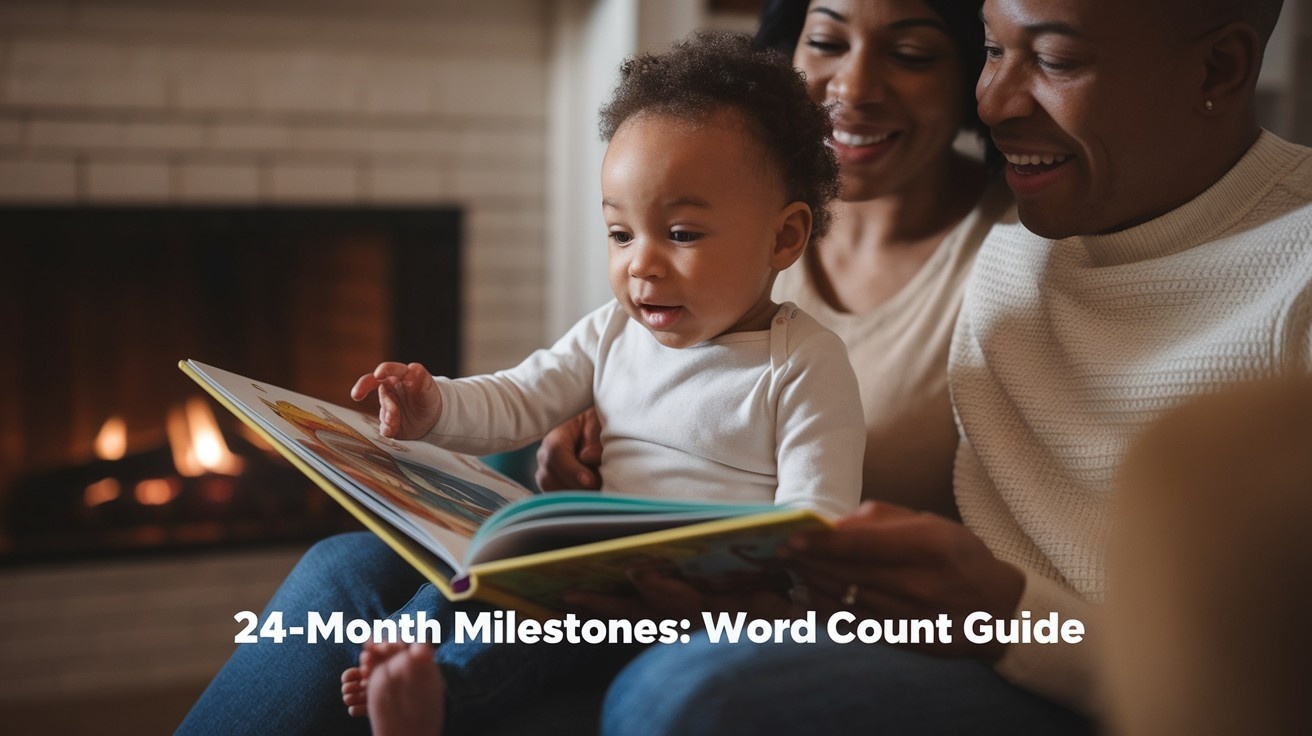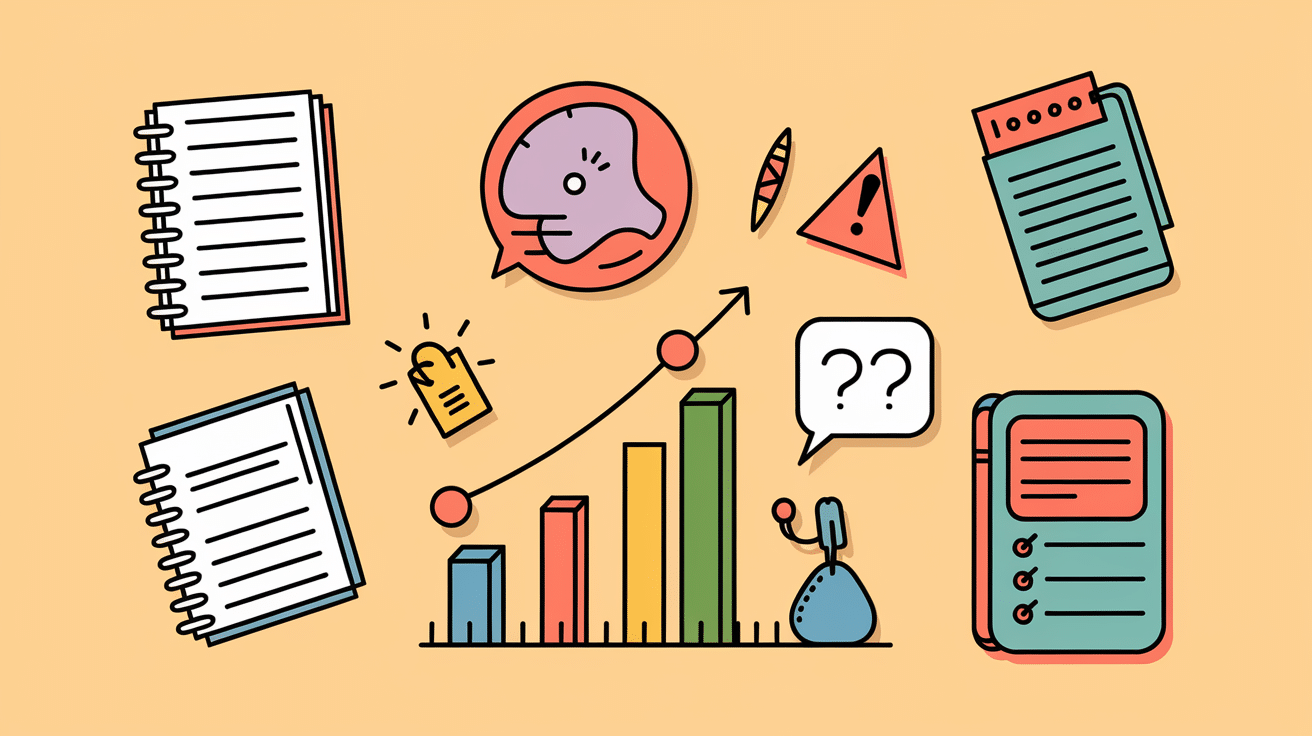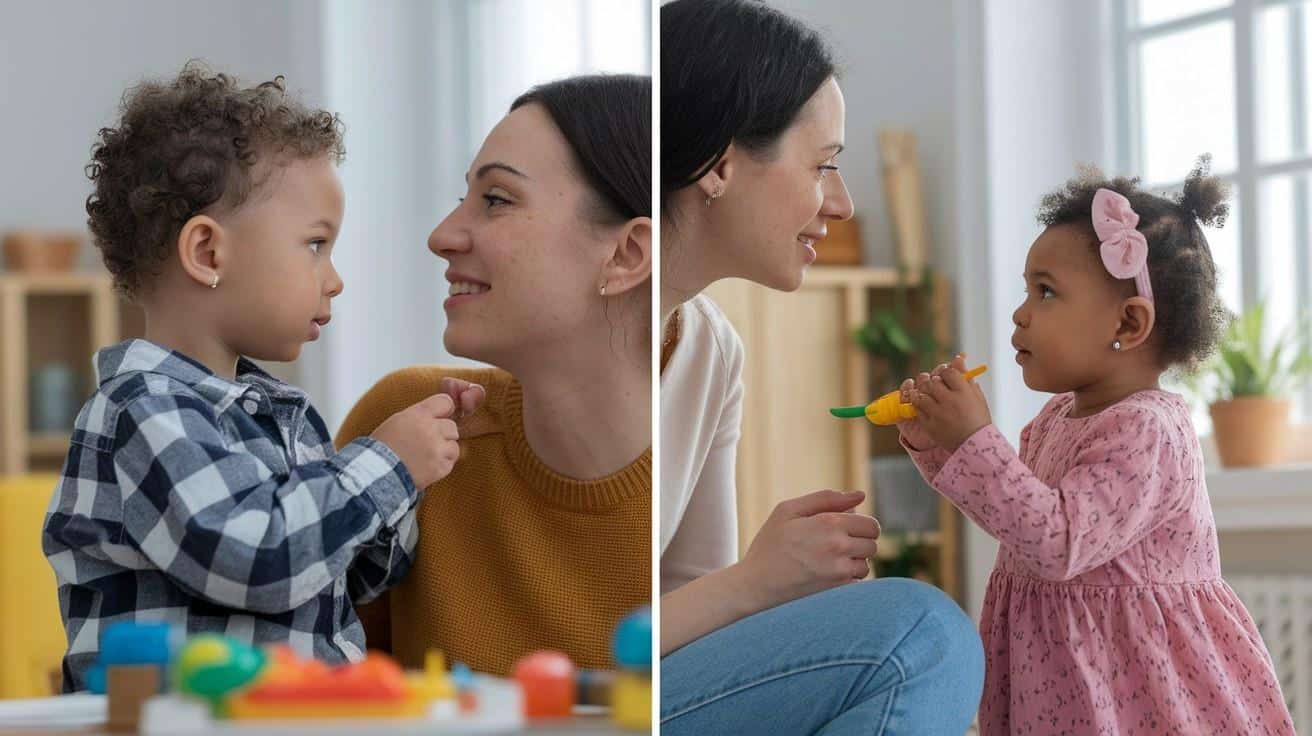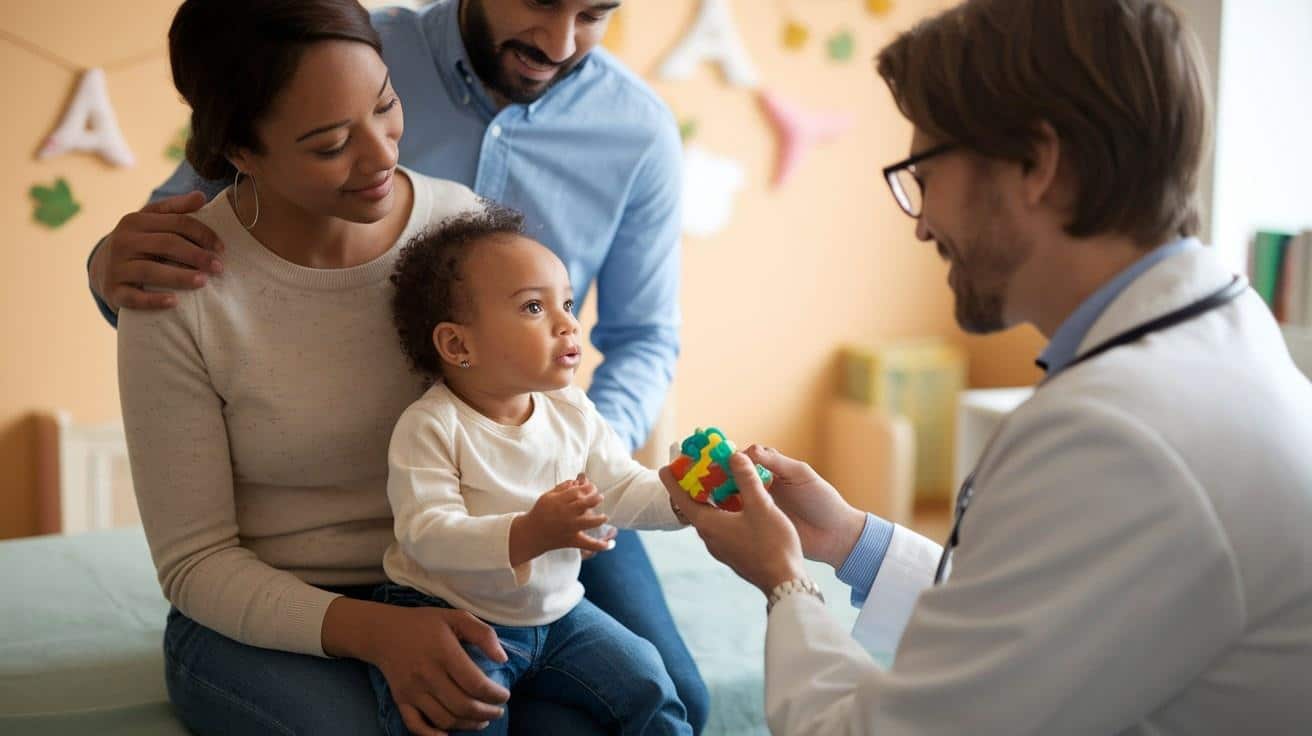
Your toddler’s growing vocabulary isn’t just adorable—it’s a crucial milestone in their brain development.
Those first words open doors to connection, learning, and, eventually, reading success. Language skills at age two can even predict academic achievement years later.
No wonder many parents worry when comparing their child’s word count to others or to what “experts” say is normal.
Is your little one saying enough? Should they be speaking in sentences already? Is their pronunciation concerning?
This blog probes the typical vocabulary of a 24-month-old, the surprising range of “normal” development, and signs of healthy communication beyond mere word counts.
We’ll cover when to be concerned, how to support language growth, and when professional help might be needed—giving you practical guidance for this important developmental stage.
Typical Vocabulary Milestones for 24-Month-Olds

By the age of 24 months, most toddlers have a vocabulary ranging from 50 to 300 words. This wide range is completely normal.
At this stage, children understand far more words (receptive language) than they can speak (expressive language). Many parents notice their children understand complex instructions even when their speaking abilities lag behind.
Two-year-olds typically use nouns for familiar people and objects (mama, dada, ball, milk), simple action words (go, eat, up), descriptive words (hot, big, yucky), and social words (hi, bye, please).
They’re also beginning to combine two words, forming simple phrases like “more juice” or “daddy shoe.”
Tracking Your Child’s Progress

Keeping track of your child’s vocabulary growth helps you celebrate progress and identify concerns early. A simple notebook where you jot down new words your toddler uses can be surprisingly effective.
Date each entry to see how quickly their language expands. Several smartphone apps like “Tiny Tracker” and “Speech Buddy” let you record words and track developmental milestones with helpful reminders about what to expect next.
If you notice your child falling behind expected milestones, document specific examples of communication struggles.
Note what they can and cannot say, along with any frustration behaviors. This detailed information will be valuable when speaking with your pediatrician about possible next steps.
How to Support Your Toddler’s Language Development?

Boosting your toddler’s language skills happens through everyday moments. Narrate your activities as you cook, shop, or play together, using simple but varied words.
When your child points or makes sounds, respond by naming what interests them. Reading books daily exposes them to new vocabulary in meaningful contexts.
1. Talk Throughout Your Day
Use daily routines as language-learning opportunities. During bath time, name body parts and describe water sensations.
While dressing, discuss clothing colors and weather. In the kitchen, introduce food names and cooking actions. These everyday conversations build vocabulary naturally.
2. Create a Language-Rich Environment
Surround your child with diverse words. Sing songs with actions, play simple games like peek-a-boo, and use different voices when reading stories.
Name emotions as they experience them: “You look frustrated with that puzzle” or “You’re smiling—you seem happy!”
3. Follow Your Child’s Lead
Pay attention to what interests your toddler. When they show curiosity about something, they expand on it with simple descriptions.
If they point to a dog, respond with, “Yes, that’s a big brown dog. He’s barking!” This teaches them that communication is rewarding and meaningful.
4. Welcome Repetition
Toddlers learn through repetition. Read their favorite books repeatedly, sing the same songs, and use familiar phrases during routines.
This consistency helps them recognize patterns in language and gradually master new words.
5. Use Parallel Talk and Self-Talk
Narrate what your child is doing (parallel talk): “You’re stacking the blocks so high!” Also, verbalize your actions (self-talk): “I’m cutting the apple into slices.”
These techniques model language without demanding responses. Additionally, this consistent language exposure builds a strong foundation for your child’s communication skills.
6. Create Conversation Opportunities
Set up situations where communication is necessary. Put favorite toys in visible but unreachable places, give small portions so they need to ask for more, or “forget” essential items during routines to encourage requests.
This not only sparks conversation but also boosts problem-solving skills and independence.
7. Be Patient and Responsive
Respond to all communication attempts, even imperfect ones. If your child says “wa” while pointing to water, respond enthusiastically: “Water! You want water. Here’s your water.”
This validates their efforts and builds confidence. Over time, this consistent reinforcement encourages your child to take risks with language and deepens their trust in communicating.
Signs of Healthy Language Development Beyond Word Count

Word count isn’t the only way to gauge your toddler’s language development. Watch how your child responds to simple directions like “get your shoes” or “give the ball to daddy.” A child who follows these requests shows strong comprehension skills.
Notice how they try to communicate their needs—through pointing, meaningful sounds, or attempts at words. Most two-year-olds understand far more words than they can say, often recognizing hundreds of words while speaking fewer.
Look for purposeful gestures like waving goodbye, nodding yes, or shaking their heads no. These nonverbal communication skills demonstrate your child’s understanding of social language and desire to connect with others—important foundations for speech development.
Do Boys and Girls Develop Language Differently?

1. Research on Gender Differences in Language:
Studies suggest that girls may begin speaking earlier and develop slightly larger vocabularies during early childhood.
However, these differences are subtle and represent general trends rather than strict rules, as each child’s language development follows its unique path.
2. Interpreting These Differences:
Biological factors and social expectations both influence language development. Parental interaction styles and cultural norms further shape these differences, highlighting the balance between innate abilities and environmental influences.
Individual temperament and exposure to diverse communication experiences can further shape how and when language milestones are reached.
3. Why Individual Development Matters More:
Each child follows a unique developmental trajectory, influenced by factors such as temperament, exposure, and learning pace.
As a result, focusing on individual progress is more beneficial than relying solely on gender-based averages.
Recognizing and supporting these individual paths fosters more effective and personalized language development. It also helps build confidence and reduces unnecessary pressure on both children and caregivers.
4. Environmental and Cultural Influences:
Rich language exposure at home and in the community, including engaging activities like storytelling, plays a significant role in language acquisition.
In fact, quality interactions can be more important than gender in shaping a child’s language skills.
Daily conversations, reading routines, and cultural storytelling traditions help expand vocabulary and strengthen communication skills.
Consistent, meaningful interaction nurtures not only language but also social and emotional development.
5. Role of Parental Interaction:
Parents may use different language styles with boys and girls, which can subtly impact their development.
However, encouraging open, engaging, and varied communication is essential for fostering strong language skills in every child.
Simple everyday conversations, shared reading, and active listening can greatly enhance vocabulary and comprehension.
Creating a supportive and language-rich environment empowers children to express themselves confidently and clearly.
6. Variability Within Genders:
There is considerable variability among both boys and girls, with some children outperforming others regardless of gender.
This emphasizes that language development is highly individualized and highlights the importance of supporting each child’s unique pace and abilities.
Focusing on strengths rather than comparisons encourages more positive developmental progress.
Recognizing this diversity helps caregivers and educators provide more tailored support for every child’s needs.
7. Impact of Early Childhood Education:
High-quality early education programs and targeted language interventions can significantly boost language acquisition, while structured educational experiences tailored to individual learning styles benefit children irrespective of gender.
Educators who foster inclusive, language-rich classrooms help build strong communication foundations.
Early support not only enhances vocabulary and grammar but also nurtures confidence and a love for learning.
When to Be Concerned About Speech Development?

While development varies, certain red flags warrant attention. By 24 months, be concerned if your child uses fewer than 50 words, doesn’t combine words, or seems unable to follow simple instructions.
Also, watch for regression—losing words they once used—or showing no interest in communicating.
Some milestones shouldn’t be missed: by 18 months, children should use meaningful words; by 24 months, they should understand simple commands and use two-word phrases.
A “late talker” typically has good comprehension, uses gestures effectively, and shows no other developmental concerns. A true language delay affects both understanding and expression, often alongside other developmental issues.
If you’re worried, trust your instincts and consult your pediatrician—early intervention makes a significant difference.
When to Seek Professional Help?
Contact your pediatrician if your two-year-old uses fewer than 50 words, doesn’t combine words, or shows limited understanding.
If you have concerns, don’t wait until your next scheduled visit. The doctor may recommend a speech-language evaluation, which typically involves play-based activities to assess both understanding and speaking abilities.
A speech-language pathologist will observe how your child communicates, follows directions, and produces sounds. If delays are identified, early intervention services are often available at low or no cost.
Research shows remarkable success rates for therapy started before age three. These services might include parent coaching, group therapy, or individual sessions—all designed to build essential communication skills during this critical developmental window.
Final Thoughts
Remember that language development in toddlers follows a remarkably varied path. While the average 24-month-old uses 50-300 words, your child’s unique trajectory matters more than hitting specific number targets.
The quality of their communication attempts, comprehension skills, and desire to connect with others are equally important indicators of healthy development.
Focus on creating language-rich daily interactions, responding to all communication attempts, and reading together regularly. These simple practices have powerful effects on vocabulary growth.
Trust your instincts if you’re concerned. Early intervention, when needed, makes a tremendous difference.
But also take comfort in knowing that many “late talkers” catch up completely without intervention.
Your attentive parenting, paired with appropriate professional guidance when necessary, gives your child the best foundation for communication success—regardless of exactly when those precious words begin flowing.
